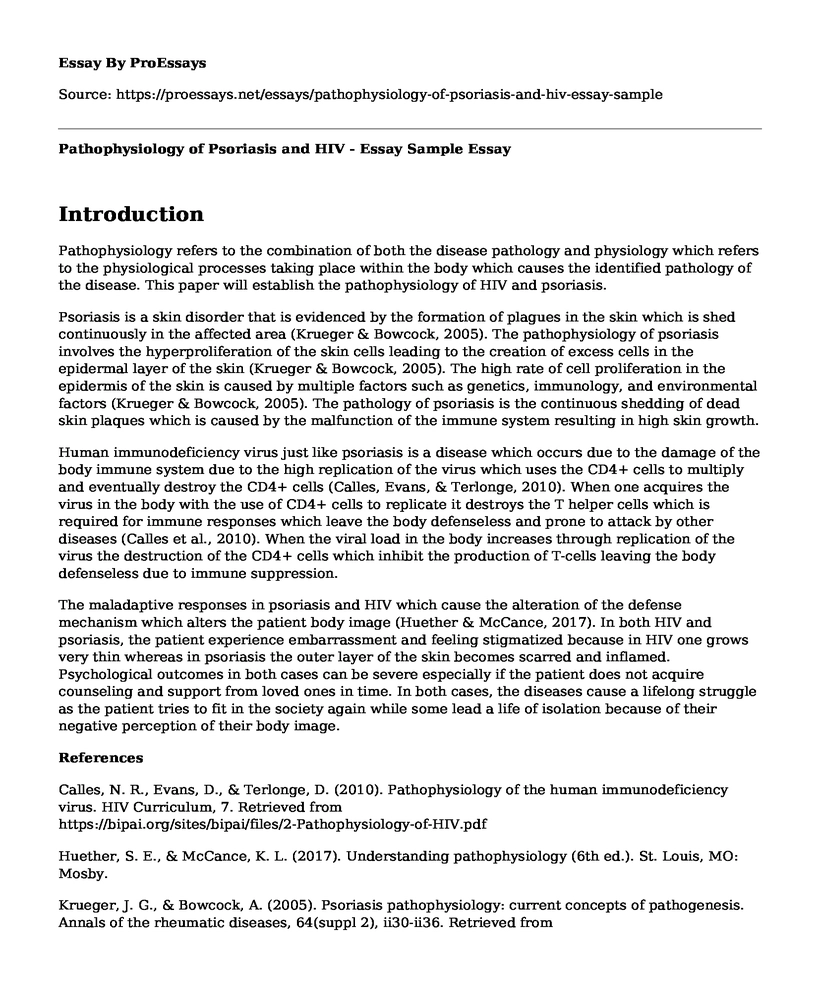Introduction
Pathophysiology refers to the combination of both the disease pathology and physiology which refers to the physiological processes taking place within the body which causes the identified pathology of the disease. This paper will establish the pathophysiology of HIV and psoriasis.
Psoriasis is a skin disorder that is evidenced by the formation of plagues in the skin which is shed continuously in the affected area (Krueger & Bowcock, 2005). The pathophysiology of psoriasis involves the hyperproliferation of the skin cells leading to the creation of excess cells in the epidermal layer of the skin (Krueger & Bowcock, 2005). The high rate of cell proliferation in the epidermis of the skin is caused by multiple factors such as genetics, immunology, and environmental factors (Krueger & Bowcock, 2005). The pathology of psoriasis is the continuous shedding of dead skin plaques which is caused by the malfunction of the immune system resulting in high skin growth.
Human immunodeficiency virus just like psoriasis is a disease which occurs due to the damage of the body immune system due to the high replication of the virus which uses the CD4+ cells to multiply and eventually destroy the CD4+ cells (Calles, Evans, & Terlonge, 2010). When one acquires the virus in the body with the use of CD4+ cells to replicate it destroys the T helper cells which is required for immune responses which leave the body defenseless and prone to attack by other diseases (Calles et al., 2010). When the viral load in the body increases through replication of the virus the destruction of the CD4+ cells which inhibit the production of T-cells leaving the body defenseless due to immune suppression.
The maladaptive responses in psoriasis and HIV which cause the alteration of the defense mechanism which alters the patient body image (Huether & McCance, 2017). In both HIV and psoriasis, the patient experience embarrassment and feeling stigmatized because in HIV one grows very thin whereas in psoriasis the outer layer of the skin becomes scarred and inflamed. Psychological outcomes in both cases can be severe especially if the patient does not acquire counseling and support from loved ones in time. In both cases, the diseases cause a lifelong struggle as the patient tries to fit in the society again while some lead a life of isolation because of their negative perception of their body image.
References
Calles, N. R., Evans, D., & Terlonge, D. (2010). Pathophysiology of the human immunodeficiency virus. HIV Curriculum, 7. Retrieved from https://bipai.org/sites/bipai/files/2-Pathophysiology-of-HIV.pdf
Huether, S. E., & McCance, K. L. (2017). Understanding pathophysiology (6th ed.). St. Louis, MO: Mosby.
Krueger, J. G., & Bowcock, A. (2005). Psoriasis pathophysiology: current concepts of pathogenesis. Annals of the rheumatic diseases, 64(suppl 2), ii30-ii36. Retrieved from https://ard.bmj.com/content/annrheumdis/64/suppl_2/ii30.full.pdf
Cite this page
Pathophysiology of Psoriasis and HIV - Essay Sample. (2022, Dec 09). Retrieved from https://proessays.net/essays/pathophysiology-of-psoriasis-and-hiv-essay-sample
If you are the original author of this essay and no longer wish to have it published on the ProEssays website, please click below to request its removal:
- Safety, Nutrition and Health in Early Education - Course Work Example
- Disaster Recovery Plans Research Paper
- Prophylactic Mastectomy Versus Preventive Drugs for BRCA1 and BRAC2 Gene Mutation Carriers Investigative Report
- Case Diagnosis: Osteoarthritis Paper Example
- Data Collection Methods in Nursing Research Paper Example
- Examples of Three Presentations on Medicine and Healthcare
- QlikView Hospital Activity - Report Example







